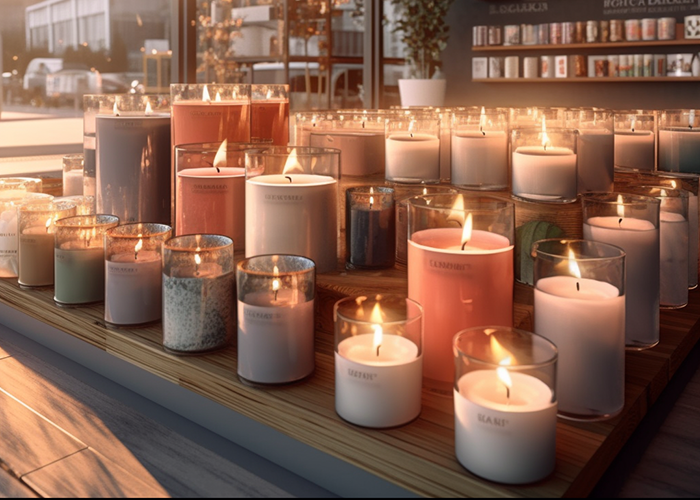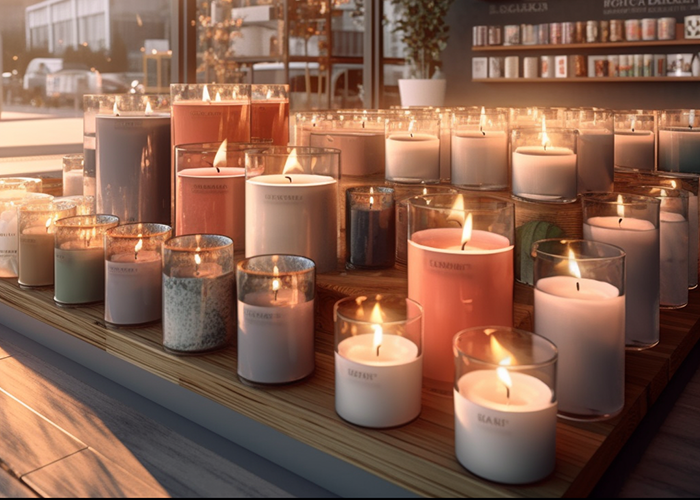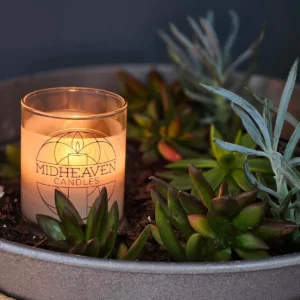In this comprehensive article, we’ll provide you with essential tips and techniques to ensure that your candles retain their delightful scents and pristine condition over time.
We’ll explore factors such as temperature, humidity, light exposure, and container type, all of which play crucial roles in preserving candle integrity.
By understanding these factors and implementing proper storage practices, you’ll be able to enjoy your candles for longer periods without experiencing fragrance loss or quality degradation.
From selecting an appropriate storage location to addressing common mistakes and considering long-term storage considerations, this guide covers everything you need to know to keep your candles fresh and fragrant.
Let’s dive in and discover how to store your candles effectively for maximum enjoyment!

Understanding Factors Affecting Candle Storage:
Temperature, humidity, light exposure, and container type are key factors influencing how well candles maintain their fragrance and quality during storage.
Temperature plays a crucial role, as high temperatures can cause candles to soften or even melt, while low temperatures can affect fragrance diffusion. Similarly, humidity levels can impact the texture and burn quality of candles, with excessive moisture leading to sweating or frosting on the candle’s surface.
Light exposure, especially to direct sunlight, can accelerate fragrance evaporation and cause color fading in candles. Therefore, it’s essential to store candles away from windows or other sources of intense light to minimize these effects.
The type and material of the container also influence storage outcomes. Airtight containers help prevent fragrance evaporation and protect candles from dust and debris, while non-porous materials like glass or metal provide better protection against moisture and air exposure compared to porous materials like cardboard or paper.
Understanding these factors allows you to make informed decisions when selecting storage locations and containers for your candles. By controlling these variables to the best of your ability, you can ensure that your candles remain in optimal condition for longer periods, providing you with continued enjoyment of their fragrance and ambiance.
Best Practices for Storing Candles:
Implementing proper storage practices is essential for preserving the fragrance and quality of your candles. Here are some guidelines to help you store your candles effectively:
Choosing an Appropriate Storage Location:
Select a storage location that maintains stable temperature and humidity levels. Avoid areas prone to temperature fluctuations, such as attics or basements, as well as humid environments like bathrooms. Opt for a cool, dry area away from direct sunlight and heat sources, such as radiators or stoves.
Proper Storage Containers and Techniques:
Invest in airtight containers to minimize exposure to air and moisture, which can accelerate fragrance evaporation and degrade candle quality. Glass jars with tight-fitting lids or plastic containers with secure seals are excellent choices for storing candles. Ensure that the containers are clean and dry before placing candles inside to prevent contamination.
Strategies for Organizing and Protecting Candles:
When storing multiple candles together, avoid stacking them or placing heavy objects on top, as this can cause deformation or damage. Instead, arrange candles upright in rows or layers to maximize space and airflow. Consider using dividers or separators to prevent candles from touching each other and causing scratches or dents.
Rotation and Inspection:
Regularly inspect your candle collection for signs of deterioration, such as discoloration, sweating, or changes in texture. Rotate candles periodically to ensure even exposure to the storage environment and prevent scent stagnation. If you notice any issues, such as fragrance loss or damage, take corrective action promptly to prevent further deterioration.
By following these best practices for storing candles, you can prolong their fragrance and quality, ensuring that they remain a source of enjoyment for years to come.
Maximizing Fragrance Retention:
Preserving the fragrance of your candles is paramount for maintaining an enjoyable aromatic experience. Here are some techniques to help maximize fragrance retention during storage:
Proper Sealing of Containers:
Ensure that the storage containers are tightly sealed to prevent air and moisture from infiltrating. This will help preserve the scent potency of the candles and prevent fragrance evaporation over time. Check the seals regularly to ensure they remain intact and effective.
Rotation of Candle Stock:
Rotate your candle stock regularly to prevent scent stagnation. By using older candles first and cycling through your collection, you ensure that all candles receive exposure to the storage environment, helping to maintain their fragrance potency. Consider implementing a system to track the age of your candles and prioritize their usage accordingly.
Avoid Overstocking:
Avoid overcrowding your storage space with an excessive number of candles. Overstocking can lead to poor airflow and uneven exposure to the storage environment, potentially compromising fragrance retention. Instead, maintain a manageable inventory of candles that allows for adequate spacing and airflow between them.
Storage Location Considerations:
When selecting a storage location for your candles, prioritize areas with minimal temperature fluctuations and exposure to light and humidity. Cool, dark, and dry spaces are ideal for preserving fragrance potency. Avoid storing candles in areas prone to temperature extremes or fluctuations, such as near heaters or air conditioning vents.
By implementing these techniques, you can effectively maximize fragrance retention and prolong the aromatic lifespan of your candles.
Common Mistakes to Avoid:
While storing candles, it’s crucial to be mindful of common mistakes that can compromise fragrance retention and overall quality. Here are some pitfalls to avoid:
Exposure to Direct Sunlight: Placing candles in direct sunlight can accelerate fragrance evaporation and cause color fading. Avoid storing candles near windows or other sources of intense light to prevent these effects.
Improper Sealing: Failing to properly seal storage containers can allow air and moisture to infiltrate, leading to fragrance loss and degradation. Ensure that containers are tightly sealed to maintain scent potency.
Overcrowding: Overstocking your storage space with too many candles can hinder airflow and proper ventilation, affecting fragrance retention. Keep your candle inventory manageable to allow for adequate spacing and airflow between candles.
Inadequate Temperature Control: Storing candles in areas prone to temperature fluctuations, such as attics or basements, can impact fragrance stability. Choose storage locations with stable temperatures to minimize fluctuations and preserve scent potency.
Incorrect Storage Materials: Using improper storage materials, such as plastic bags or cardboard boxes, can affect candle quality. Opt for airtight containers made of glass or metal to protect candles from air, moisture, and light exposure.
Ignoring Rotation: Neglecting to rotate your candle stock can result in uneven exposure to the storage environment, leading to scent stagnation and degradation. Rotate candles regularly to ensure consistent fragrance potency.
Ignoring Expiration Dates: Candles, like other products, have expiration dates. Using expired candles can result in diminished fragrance and quality. Check expiration dates and prioritize using older candles first.
By avoiding these common mistakes, you can effectively preserve the fragrance and quality of your candles, ensuring a delightful aromatic experience every time you light them.
Addressing Specific Candle Types and Materials:
Different types of candles and materials may require specific storage considerations to maintain fragrance and quality. Here’s a closer look at how to store various candle types and materials:
Jar Candles: Store jar candles in a cool, dark place to prevent fragrance evaporation and discoloration. Ensure that the lids are tightly sealed to maintain scent potency.
Pillar Candles: Pillar candles should be stored upright to prevent warping or bending. Consider wrapping them in tissue paper or bubble wrap to protect them from dust and debris.
Taper Candles: Taper candles are best stored in a vertical position to maintain their shape. Keep them away from direct sunlight and heat sources to prevent melting or distortion.
Soy Wax Candles: Soy wax candles are sensitive to temperature fluctuations and should be stored in a cool, dry place. Avoid exposing them to extreme temperatures to prevent sweating or frosting.
Beeswax Candles: Beeswax candles are prone to melting in high temperatures. Store them in a cool location away from direct sunlight to maintain their shape and fragrance.
Paraffin Wax Candles: Paraffin wax candles can absorb odors from the environment, affecting their fragrance. Store them in airtight containers to prevent odor absorption and preserve scent potency.
Conclusion:
Proper storage is essential for maintaining the fragrance and quality of your candles over time. By implementing best practices such as choosing an appropriate storage location, using proper containers, and avoiding common mistakes, you can prolong the aromatic lifespan of your candles. Remember to be mindful of factors such as temperature, humidity, and light exposure, as well as the specific needs of different candle types and materials. With these strategies in place, you can continue to enjoy the delightful scents and ambiance provided by your candles for years to come.




